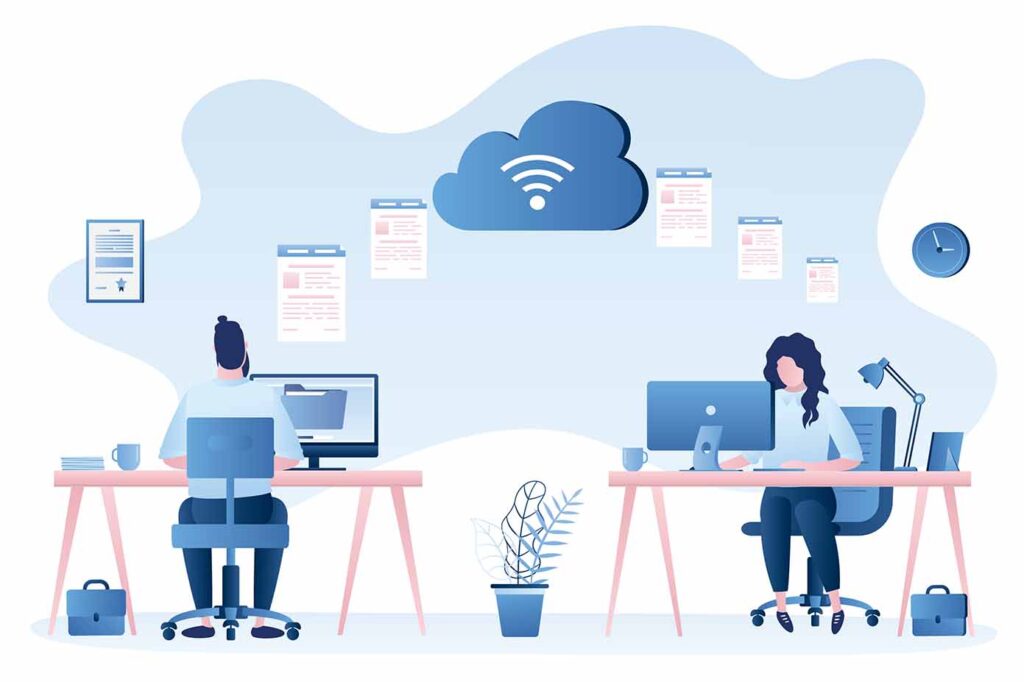Journalists, forward-thinking business owners, and employees alike have touted the benefits of working remotely for years. While cloud technology once made it a viable option, the COVID-19 pandemic rapidly turned it into a necessity. The transition to remote work was not without its growing pains, but as experience has shown, it has been the single most important factor in allowing business to stay open.
So what will happen to your organization when it’s safe to go back to the office? Will you resume business as usual, breathing a sigh of relief that you’re done with Zoom meetings? Will you brush off the brief period of having your employees working remotely and get back to normal?
What Normal Will Look Like

You will undoubtedly have the option to resume work on-site, and in many cases that will be necessary. However, something will nag at you as you try to move forward: there is no such thing as getting back to normal.
Why not? First, we’re not done with the pandemic. It will continue as we go into the summer. As Ed Yong writes in The Atlantic, “the only viable endgame is to play whack-a-mole with the coronavirus, suppressing it until a vaccine can be produced. With luck, that will take 18 to 24 months. During that time, new outbreaks will probably arise.”
Here in New Jersey, Governor Murphy agrees with that assessment. Quoted in a Politco article, he says: “The notion that we’re going to go back to some sort of, let’s just turn the clock back to three months ago, I just don’t see it.”
A Long-Term Remote Working Reality
With new outbreaks will come more quarantines, sending employees back to working from home. Simply, that means your company’s remote work setup is here to stay for at least the next two years. The best thing you can do in the short-term is refine your remote operations.
But there’s a bigger picture here: businesses shouldn’t see remote work as a bunker in which they hide. Instead, they should take full advantage of the flexibility and productivity that can only be achieved by working remotely. As Enrique Dans writes in Forbes, “Shouldn’t the lessons learned during lockdown and the fight against COVID-19 encourage change?”
He continues: “If many companies have been forced to try out teleworking, should they not, once the emergency is over, move on to offer their workers flexible systems that allow them to work from home, in a climate of trust that will enable them, for example, to avoid rush hour and be more productive in the process?”
Though it may not seem obvious, your business has been given an opportunity to approach work in a new way. With a permanent remote solution, you can now be more flexible while maintaining employment and optimizing productivity.
Solutions to Smarter Remote Work

Many business owners fear that remote work environments don’t allow them to see, understand, or review employee productivity. That’s why any remote working solution should include tracking and reporting capabilities for time and tasks.
But the same recommendation holds true for businesses operating 100% on-site. It isn’t a foregone conclusion that people working in proximity have the same oversight and quality control that modern employee tracking tools provide.
In fact, the steps you can take to ensure employees can not only work productively, but also achieve the agility to shift between on-site and remote setups. These are just a few:
- Give your employees some guidelines on how to optimize their productivity while staying sane at home. You can read 15 tips for doing just that right here.
- Take some internal surveys and discuss remote setups with your teams. What’s working and what isn’t? As soon as you’re out of panic mode, you’ll get a clear-eyed sense of how to implement things the right way next time.
- Prepare your employees for the reality that they may be back at home again in a month, two months, or more. While there is plenty of uncertainty to come, you can mitigate confusion by drafting a clear preparedness plan and sharing it with everyone.
- Make sure you have the right remote working tools. Slack and Zoom aren’t the only things that are going to run your business. You need to power core processes and your biggest operations remotely as well. Centralize things as much as possible, and favor systems instead of collections of tools.
Take the First Step Now
If nearly every prediction is correct, we’re all in for a very bumpy ride throughout the next year. Arguably, the biggest bump has already happened. But we can’t let subsequent disruptions have the same negative impacts on business. Working from home isn’t just a necessity— it’s a competitive advantage.

Sending employees home to work and optimizing their productivity can go hand-in-hand. You’ll need to be prepared next time. The good news is that your experience has given you all the information you need to make the right decisions, especially for a more permanent remote work option. Start setting it up now so your future can look much more certain.

